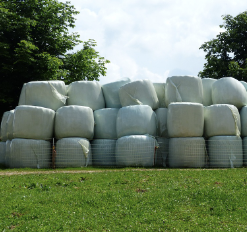In the realm of agriculture, efficiency and preservation are paramount. Farmers constantly seek ways to maximize yields while ensuring the quality and longevity of their produce. One essential tool in this pursuit is heavy duty bale wrap. This versatile solution plays a crucial role in preserving forage quality and safeguarding hay bales during storage and transportation. In this article, we delve into the significance of heavy-duty bale wrap, its benefits, and its impact on modern farming practices.
Understanding Heavy Duty Bale Wrap
 Heavy-duty bale wrap, also known as silage wrap or bale silage, is a specialized plastic film used to encase hay bales or silage. This durable material serves multiple purposes, primarily aimed at preserving forage quality and protecting the bales from external elements such as moisture, oxygen, and UV radiation.
Heavy-duty bale wrap, also known as silage wrap or bale silage, is a specialized plastic film used to encase hay bales or silage. This durable material serves multiple purposes, primarily aimed at preserving forage quality and protecting the bales from external elements such as moisture, oxygen, and UV radiation.
The Importance of Preservation
Preservation is a cornerstone of modern agricultural practices, particularly in the context of forage management. When forage undergoes proper preservation, it retains its nutritional value and palatability, ensuring optimal feed quality for livestock. Heavy-duty bale wrap forms a barrier that seals in moisture and excludes oxygen, creating anaerobic conditions ideal for fermentation—a key process in silage production. By inhibiting the growth of spoilage microorganisms, the wrap helps extend the shelf life of forage, allowing farmers to store it for longer periods without compromising its nutritional integrity.
Benefits of Heavy Duty Bale Wrap
- Preservation of Nutritional Value: The anaerobic environment created by heavy-duty bale wrap promotes lactic acid fermentation, which preserves the nutritional content of forage, including proteins, carbohydrates, and vitamins.
- Reduced Dry Matter Loss: Effective sealing with bale wrap minimizes exposure to air and moisture, significantly reducing dry matter losses compared to uncovered or loosely wrapped bales.
- Enhanced Digestibility: Properly preserved forage is more digestible for livestock, leading to improved feed efficiency and overall animal health.
- Year-Round Availability: Heavy-duty bale wrap enables farmers to harvest and store forage at peak nutritional value, ensuring a consistent feed supply throughout the year, regardless of seasonal fluctuations.
- Weather Resistance: The robust construction of heavy duty bale wrap shields bales from adverse weather conditions, such as rain, snow, and wind, preventing spoilage and maintaining feed quality.
- Ease of Handling: Modern bale wrapping equipment facilitates efficient application of the wrap, allowing farmers to streamline the harvesting and storage process with minimal labour requirements.
Application and Techniques
Applying heavy-duty bale wrap requires precision and attention to detail to ensure optimal preservation and longevity. Here are some key techniques:
- Proper Bale Density: Achieving the right bale density is crucial for effective wrapping. Bales should be compact enough to minimize air pockets but not overly tight, which could hinder fermentation.
- Even Coverage: The wrap should be applied evenly and tightly around the bale to create a seamless seal. Overlapping layers by 50% ensure complete coverage and minimize the risk of tears or punctures.
- Secure End Sealing: Properly sealing the ends of the bale wrap prevents air infiltration and maintains the integrity of the silage. Secure the ends with reliable closures or film layers to avoid unravelling.
- Timely Wrapping: Prompt wrapping immediately after baling is essential to preserve forage quality. Delayed wrapping increases the risk of nutrient losses and compromises fermentation efficiency.
Future Trends and Innovations
As agricultural technology continues to evolve, so do advancements in bale wrapping solutions. Future trends in heavy-duty bale wrap may include:
- Biodegradable Materials: The development of biodegradable or compostable bale wrap materials aims to reduce environmental impact and promote sustainability in farming practices.
- Smart Monitoring Systems: Integration of sensor-based technologies allows for real-time monitoring of bale conditions, including temperature, moisture levels, and gas composition, enabling proactive management and optimization of silage quality.
- Improved Wrapping Equipment: Innovations in bale wrapping machinery focus on enhancing efficiency, accuracy, and user-friendliness with features such as automated wrapping programs and precision control systems.
Undeniably, heavy duty bale wrap plays a pivotal role in modern agriculture by ensuring the preservation and quality of forage during storage and transportation. Its ability to create an anaerobic environment, reduce dry matter losses, and protect against external elements makes it indispensable for farmers seeking to maximize efficiency and maintain feed quality. As technology advances, so too will the innovations in bale wrapping solutions, promising even greater convenience, sustainability, and effectiveness in forage management.